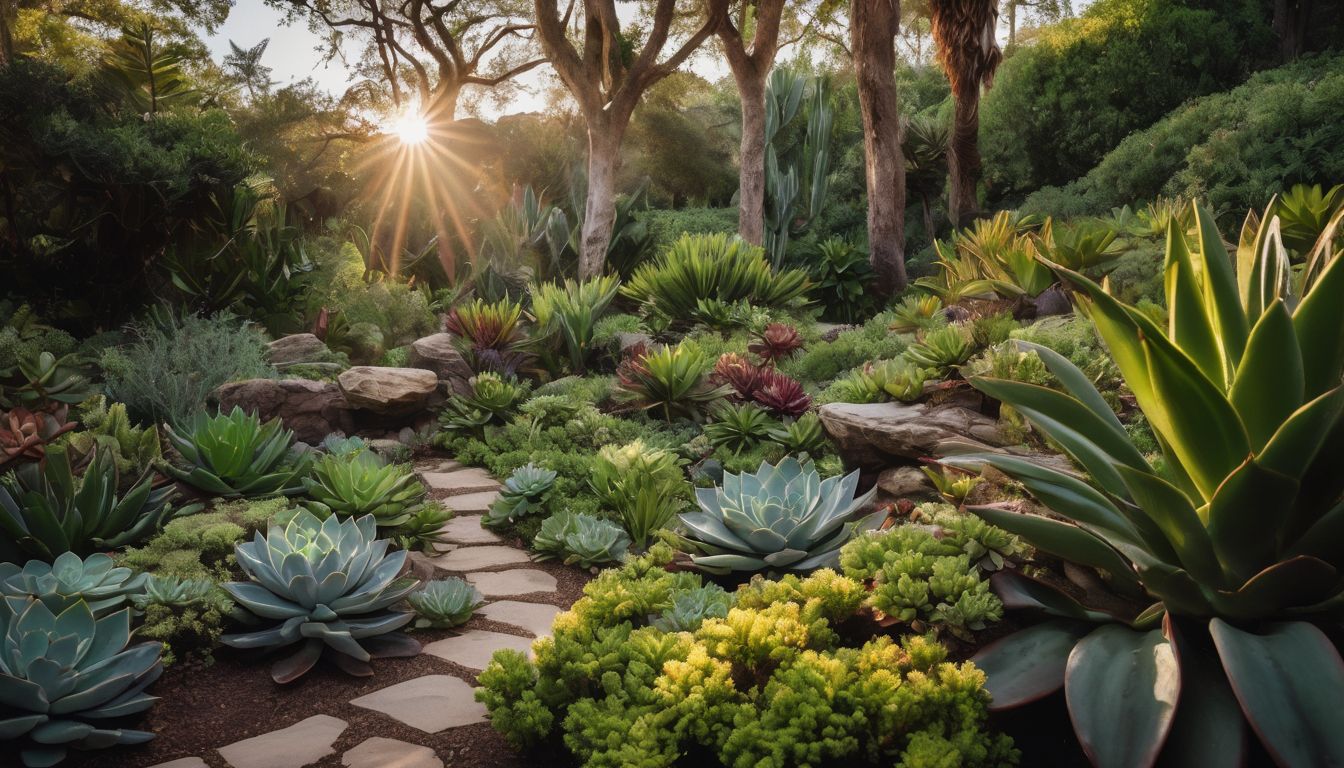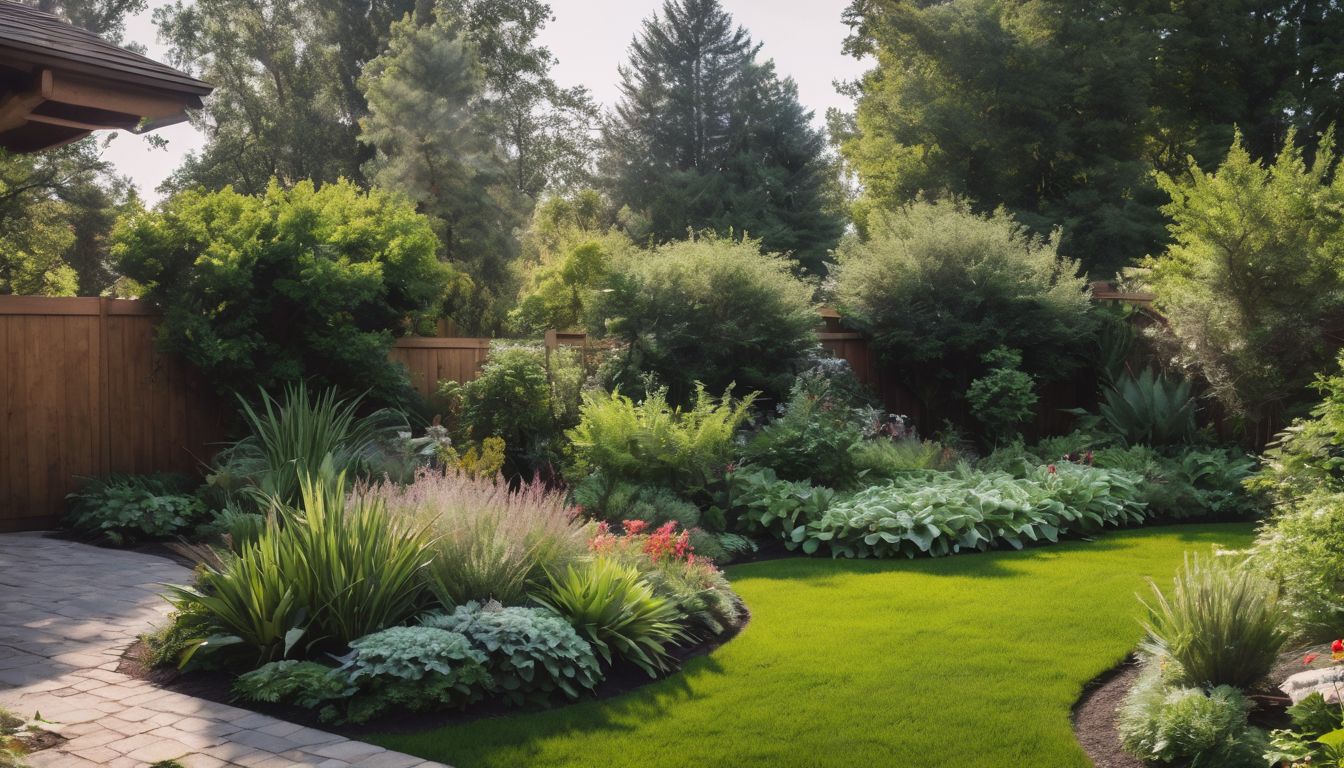Are you worried about your garden gulping down too much water? Every day, homes waste litres on thirsty lawns and flowers. Our guide to xeriscaping unlocks savvy secrets for a lush garden that sips water instead of guzzling it.
Dive in for smart gardening that saves!
Key Takeaways
- Xeriscaping is a smart gardening technique that saves water by using drought – resistant and native plants, efficient irrigation methods like drip systems, and soil improvements to increase moisture retention.
- Implementing xeriscaping principles such as mulching, reducing turf areas with alternative ground covers, and grouping plants according to their water needs can lead to less water usage and lower utility bills.
- By choosing xeriscaping for your garden or landscape, you support biodiversity by creating habitats for local wildlife and reduce the need for maintenance such as mowing and frequent watering.
What is Xeriscaping?
Moving from a broad discussion about the importance of water conservation, we now zero in on xeriscaping. This approach to gardening and landscaping allows for striking natural beauty while drastically cutting down on water use.
Xeriscaping involves designing gardens and landscapes that thrive with minimal irrigation, often through the selection of native plants and drought-resistant species. It’s an innovative way to create visually appealing outdoor spaces without placing a heavy demand on water resources.
The term ‘xeriscaping’ comes from ‘xeros,’ meaning dry, and encapsulates a method of sustainable landscaping perfect for arid climates or areas prone to droughts. However, these principles can be applied anywhere to promote eco-friendly landscaping choices that support soil improvement and efficient irrigation practices.
With xeriscaping, you go beyond mere aesthetics; it’s about making intelligent environmental decisions that align with nature’s rhythm—preserving precious water while fostering diverse ecosystems right in your backyard.
The Seven Principles of Xeriscaping
Planning and design, soil improvements, efficient irrigation, plant zoning, mulching, and turf alternatives are all essential components of xeriscaping for water conservation. These principles form the foundation of creating a sustainable and low-maintenance landscape that reduces water usage.
Planning and design
When designing a xeriscape, start by carefully planning which areas will be dedicated to specific plant groupings based on their water needs. Consider the layout of your garden or landscape and create zones for low-water plants, moderate-water plants, and high-water plants.
Choose the appropriate location for each plant grouping to ensure effective use of water resources. Incorporate shade trees strategically to reduce water evaporation and help maintain moisture in the soil.
Consider implementing efficient irrigation systems such as drip irrigation or soaker hoses to deliver water directly to the root zones of plants while minimising wastage. In addition, select native and drought-resistant plants that are well-suited to your local climate and require minimal watering once established.
Soil improvements
To ensure successful xeriscaping, incorporating soil improvements is crucial. Amending the soil with organic matter such as compost or mulch can enhance its water retention capacity, promoting healthier plant growth and reducing the need for watering.
Additionally, adding porous materials like perlite or vermiculite can improve aeration and drainage, which is essential for drought-resistant landscaping. These soil enhancements not only support water conservation efforts but also create a sustainable environment for native and drought-tolerant plants to flourish.
By implementing simple techniques such as incorporating organic matter and porous materials into the soil, xeriscapers can significantly improve their landscape’s overall sustainability.
Efficient irrigation
Implementing efficient irrigation methods is crucial in xeriscaping. Drip irrigation, soaker hoses, and moisture sensors help conserve water by delivering it directly to the roots of plants.
This reduces evaporation and runoff, ensuring that each drop counts. Mulching around plants further aids in retaining moisture while suppressing weed growth. Incorporating these techniques maximises water usage, making xeriscaping an eco-conscious choice for landscaping.
Installing drip irrigation systems alongside mulching provides direct watering to plant roots while reducing water loss through evaporation and runoff. This approach ensures that every drop of water counts, contributing to sustainable landscaping practices.
Plant zoning
When designing a xeriscape, it’s essential to consider plant zoning. This involves grouping plants with similar water needs together in the landscape. By doing so, you can ensure efficient water usage and create microclimates that support the growth of specific plant species.
Implementing this practice not only enhances the aesthetic appeal of your garden but also promotes sustainable water conservation.
Moving on to “Mulching” techniques for effective xeriscaping..
Mulching
After considering plant zoning, the next step in xeriscaping involves mulching. Mulching helps to conserve water by reducing moisture evaporation from the soil, regulating soil temperature, and suppressing weed growth.
Applying a layer of organic mulch around plants also improves soil structure and fertility over time, promoting healthier root systems for better water absorption. Additionally, it adds an aesthetic appeal to the landscape while serving as a protective barrier against erosion.
Furthermore, mulching can help prevent runoff during heavy rainfall and reduces the need for frequent watering. Using materials such as wood chips, bark mulch, or compost will not only contribute to water conservation but also enhance the overall sustainability of your xeriscape garden.
Turf alternatives
When it comes to xeriscaping, reducing or eliminating traditional lawns is a significant step towards water conservation. Instead of thirsty grass, consider low-water ground covers like clover, thyme, or sedum.
These alternatives require less irrigation and mowing, contributing to reduced water consumption and lower maintenance needs. Additionally, they can provide attractive green spaces while supporting biodiversity in the garden.
To further minimise the need for water-thirsty turf, consider using hardscaping elements such as pavers, gravel pathways, or decorative rocks to create visually appealing areas in your landscape.
Benefits of Xeriscaping for Water Conservation
– Xeriscaping reduces water consumption, lowers utility bills, minimises maintenance, improves soil health and enhances biodiversity. Read on to discover the practical tips for implementing xeriscaping in your own garden.
Reduced water consumption
Xeriscaping significantly reduces water consumption by using drought-resistant plants, minimal turf, and efficient irrigation systems. This environmentally conscious landscaping approach minimises the need for excessive watering, which helps preserve valuable water resources while promoting sustainable gardening practices.
With xeriscaping, water-efficient gardening becomes a practical reality, enabling individuals to create beautiful landscapes that thrive without placing undue strain on local water supplies.
By embracing xeriscaping principles like soil improvements, mulching to retain moisture, and strategic plant zoning based on water needs, individuals can contribute to conservation efforts and positively impact the environment.
Reduced water consumption through xeriscaping plays a pivotal role in creating eco-friendly landscapes that support biodiversity and soil health while also benefiting from lower utility bills and minimal maintenance costs associated with traditional landscaping methods.
Lower utility bills
Xeriscaping significantly reduces water usage, resulting in notably lower utility bills, making it an economical choice for environmentally conscious individuals. By incorporating drought-resistant plants and efficient irrigation systems, xeriscaping minimises the need for excessive watering, ultimately leading to cost savings on water consumption.
The strategic use of mulching also helps retain moisture in the soil, reducing the frequency of watering and contributing to decreased utility expenses.
In addition to saving on water costs, xeriscaping promotes a sustainable and eco-friendly approach to landscaping that benefits both the environment and personal finances. With reduced reliance on resources like water and energy, xeriscaping offers a practical solution for conservation-minded individuals looking to make a positive impact while saving money.
Minimal maintenance
By reducing the need for frequent watering and mowing, xeriscaping requires minimal maintenance compared to traditional landscaping. This means less time spent on upkeep and lower overall costs in caring for your outdoor space.
With the use of native plants, efficient irrigation systems, and mulching techniques, you can enjoy a beautiful garden while spending less time and effort on maintenance.
Incorporating low-water landscaping reduces the amount of pruning, weeding, and fertilising needed to keep your garden looking lush. This eco-friendly approach not only conserves water but also saves you valuable time and resources that would otherwise be spent on tending to a high-maintenance yard.
Improved soil health
To create a xeriscape garden that requires minimal maintenance like mulching and turf alternatives, you can also improve soil health. Adding organic matter such as compost or well-rotted manure to the soil helps retain moisture, promotes beneficial microbial activity, and enhances nutrient availability for plants.
This contributes to healthier, more resilient plants that require less water and maintenance over time.
Enhancing soil structure through amendments like compost or peat moss improves drainage, reduces erosion, and increases the capability of the soil to retain moisture – all crucial factors in drought-resistant landscaping.
Enhanced biodiversity
Xeriscaping enhances biodiversity by promoting the growth of native plants, which attract a diverse range of pollinators and wildlife. This landscaping technique encourages a balanced ecosystem that supports various species, contributing to the overall health and vibrancy of the environment.
Additionally, xeriscaping reduces the need for chemical inputs, fostering a more natural and sustainable habitat for flora and fauna.
By incorporating native plant species in xeriscaping design, you can create an environment that thrives with minimal water usage. Native plants are naturally adapted to local conditions, making them resilient and less dependent on external resources like water or fertilisers.
How to Xeriscape: Practical Tips
Group plants by water need, use native and drought-resistant plants, incorporate shade trees, install efficient irrigation systems, mulch to retain moisture, and reduce or eliminate traditional lawns for a water-efficient landscape.
For more practical tips on xeriscaping for water conservation, read the full article.
Group plants by water need
When choosing plants for your xeriscape garden, arrange them based on their water requirements. This ensures that each plant receives the appropriate amount of water, minimising waste and promoting efficient water usage.
By grouping plants with similar water needs together, you can tailor your irrigation system to provide targeted watering, conserving precious resources while maintaining a thriving and visually appealing landscape.
Moving on to the next principle of xeriscaping, let’s consider using native and drought-resistant plants to further enhance the sustainability of your water-efficient garden.
Use native and drought-resistant plants
Select native and drought-resistant plants to thrive in your xeriscape. These plants are well-suited to your local climate and require minimal water, making them ideal for water-wise gardening.
By incorporating these species, you can effortlessly maintain a beautiful landscape while conserving water resources. Create an eco-friendly oasis with low-water landscaping using an array of indigenous and drought-tolerant plant varieties.
Opt for native and drought-resistant plants that thrive in your area’s natural conditions. These options require less water, reducing the need for irrigation systems while sustaining a visually appealing garden or landscape.
Incorporate shade trees
Shade trees are essential in xeriscaping as they provide cooling effects, reduce water evaporation from the soil, and offer habitat for local wildlife. By strategically planting shade trees, you can lower outdoor temperatures and decrease the need for watering plants.
Choose native or drought-resistant shade trees such as mesquite or palo verde to ensure they thrive in your local climate while conserving water. Additionally, consider the placement of trees to maximise shading on your home and outdoor living areas, reducing the use of air conditioning during hot weather.
By incorporating shade trees into your xeriscaping design, you actively contribute to water conservation efforts while creating a sustainable and eco-friendly landscape that benefits both your local environment and your household.
Install efficient irrigation systems
Utilise drip irrigation to deliver water directly to plant roots, reducing wastage. Adjust the system according to weather changes and plant needs. Incorporate rain sensors to prevent watering during precipitation.
Integrate soil moisture sensors for precise irrigation control. Utilise low-flow irrigation methods and consider greywater systems for sustainable water use.
Next, let’s explore the benefits of mulching in xeriscaping.
Mulch to retain moisture
Mulch retains moisture in the soil, reducing water evaporation and minimising the need for irrigation. Organic mulches such as wood chips, straw, or bark help to maintain soil temperature and prevent rapid drying.
In addition, they break down over time and contribute to improved soil structure and fertility. Applying a 2-4 inch layer of mulch around plants also inhibits weed growth, promoting healthy plant growth while conserving water.
By using suitable keywords like “mulch,” “moisture retention,” “soil temperature,” and “organic mulches”, I provided clear instructions about retaining moisture through the use of mulch.
Reduce or eliminate traditional lawns
Consider replacing traditional lawns with low-maintenance ground covers, native plants, or artificial turf. This will significantly reduce water usage and eliminate the need for frequent mowing and chemical inputs.
By embracing alternative landscaping options, you can create a more sustainable and environmentally friendly outdoor space while still enjoying the aesthetic appeal of a green lawn.
Moving away from traditional lawns toward more water-efficient alternatives is a crucial step in xeriscaping to conserve water and support biodiversity in your local ecosystem. Let’s explore practical tips for group planting by water need.
Conclusion
In conclusion, xeriscaping offers numerous benefits for water conservation. By incorporating the seven principles, it’s possible to reduce water consumption and lower utility bills.
With practical tips like grouping plants by water need and using native species, anyone can create an eco-friendly and low-maintenance landscape that supports biodiversity. Xeriscaping is a sustainable choice for environmentally conscious individuals looking to make a positive impact on water conservation efforts.
FAQs
1. What is xeriscaping in water conservation?
Xeriscaping is a way of landscaping that reduces the need for water, using drought-resistant plants and watersaving techniques to create an eco-friendly garden.
2. Can I still have a beautiful garden with xeriscaping?
Absolutely! Xeriscaping combines water-efficient gardening with native plant landscaping to make stunning, low-water gardens that are both pretty and practical.
3. How does xeriscaping help the environment?
By using droughttolerant plants and soil improvement methods, xeriscaping conserves water, which makes it very environmentally friendly by reducing strain on water resources.
4. What type of plants should I use for my xeric garden?
Go for native and droughtresistant plants since they’re adapted to thrive without much water, making them perfect choices for a watersaving landscape.
5. Are there any special techniques used in xeriscaping?
Definitely! Employing watersaving landscaping techniques like grouping similar needs plants together and improving soil to better hold moisture will enhance your waterwise gardening efforts.





